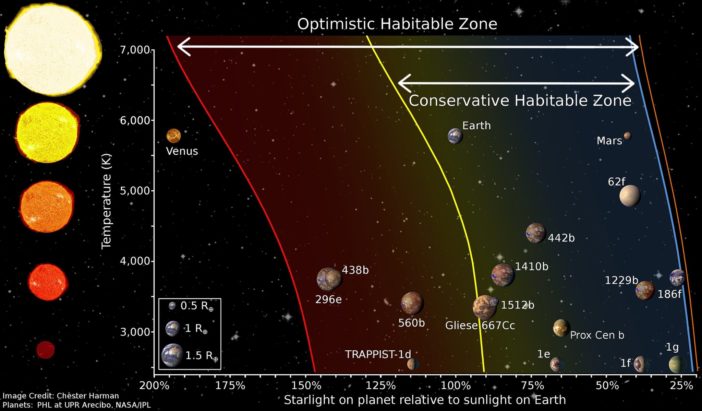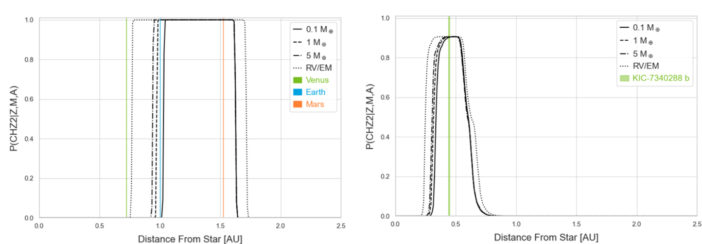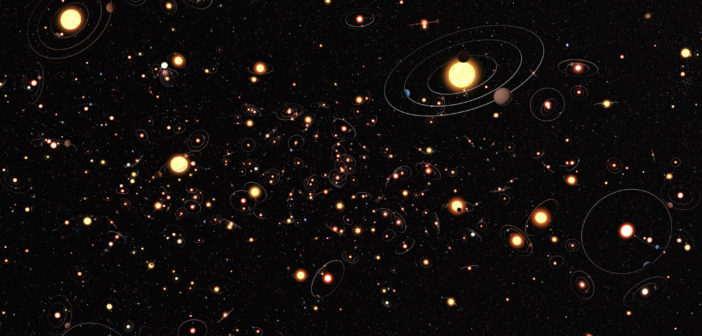Editor’s Note: Astrobites is a graduate-student-run organization that digests astrophysical literature for undergraduate students. As part of the partnership between the AAS and astrobites, we occasionally repost astrobites content here at AAS Nova. We hope you enjoy this post from astrobites; the original can be viewed at astrobites.org.
Title: Continuous Habitable Zones: Using Bayesian Methods to Prioritize Characterization of Potentially Habitable Worlds
Authors: Austin Ware et al.
First Author’s Institution: Arizona State University
Status: Published in ApJ
With more than 5,000 exoplanets discovered (roughly 30 of which are expected to be habitable), how can astronomers prioritize which to study in the search for extraterrestrial life? Today’s article explores the “continuous habitable zone”: planetary orbits that allow for water to be liquid long enough for detectable life to develop.
Habitable Worlds
With JWST beginning observations and the Habitable Exoplanet Observatory (HabEx) and Large UV/Optical/IR Surveyor (LUVOIR) space telescopes on the horizon, transit spectroscopy from space is set to dramatically increase our ability to characterize exoplanet atmospheres. Astronomers are working to prioritize which potentially habitable exoplanets are the best to search for life on. The habitable zone defines the region surrounding a star in which a planet could host liquid water, which is typically assumed to be a requirement for life. Stars evolve, though, and planets that are habitable at one point in time may not always be or have been.
Life takes time to develop and become detectable. Let’s consider Earth’s history as a benchmark. The Great Oxidation Event, during which biologically produced molecular oxygen accumulated in Earth’s atmosphere, occurred roughly 2 billion years after Earth’s formation. This is adopted as the length of time needed for life to make a detectable impact on a planet’s atmosphere. Today’s article presents a method to estimate the likelihood that a planet has resided in its star’s habitable zone for at least 2 billion years, defining the region where this could occur as the 2-billion-year continuous habitable zone (CHZ2).
So, how do we determine the habitable zone of a star? The article discussed two frameworks:
- Optimistic habitable zone: Regions that receive an amount of radiation from their star less than Venus did 1 billion years ago and more than Mars did 3.8 billion years ago ago. These “recent Venus” (RV) and “early Mars” (EM) limits are chosen because observations suggest liquid water existed on those planets until 1 or 3.8 billion years ago, respectively.
- Conservative habitable zone: A greenhouse effect model. The inner edge is defined by the “runaway greenhouse,” where stellar flux will vaporize an ocean. The outer edge is defined as the “maximum greenhouse,” where Rayleigh scattering dominates over the greenhouse effect of carbon dioxide.

Figure 1: The habitable zone for a range of stellar temperatures, showing Venus, Earth, Mars, and a selection of potentially habitable exoplanets. [Chester Harman]
Statistical Modeling
Using Bayesian statistics, the authors created an equation for the probability of a planet residing in the CHZ2 as a function of its host star’s mass, metallicity, and age. They assigned ages to the host stars based on evolutionary tracks from the Tycho stellar modeling code and found that their estimates aligned well with previous measurements based on stellar spins.
The authors used their framework to evaluate nine potentially habitable exoplanets as well as Venus, Earth, and Mars. All stars considered were relatively Sun-like (between 0.5 and 1.1 solar masses), with Earth-like and super-Earth terrestrial planets (radii < 1.8x Earth’s and mass < 10x Earth’s). Figure 2 shows the results for the solar system and the authors’ best exoplanet candidate.

Figure 2: CHZ2 probabilities for two stars. Line styles indicate the habitable zone model: three conservative model versions for different planet masses and the RV/EM optimistic model. Left: The Sun, with the orbits of Venus, Earth, and Mars indicated. Right: KIC-7340288, showing the best candidate examined in the article with ~90% CHZ2 probability under all models. [Adapted from Ware et al. 2022]
What This Means for the Future
The authors conclude with proposals for future work on this topic, including extending the analysis to lower-mass stars. They also estimated ages for nearly 3,000 Transiting Exoplanet Survey Satellite (TESS) continuous-viewing-zone stars, which are the best candidates for TESS to find habitable zone planets around, to apply a similar framework to in the future. The exoplanets determined here to have a high CHZ2 probability will be ideal for follow-up with JWST. The method will also be valuable in target selection for future exoplanet characterization missions like HabEx and LUVOIR.
As shown in Figure 2 above, the method used in this article determined Mars to be in the CHZ2, while we know it not to be currently habitable. This indicates the need for additional model parameters in the Bayesian analysis to improve accuracy. This includes further stellar and planetary properties important to their evolution, including stellar oxygen-to-iron ratios, planetary composition, and stellar activity.
Original astrobite edited by Jana Steuer.
About the author, Macy Huston:
I am a fourth-year graduate student at Penn State University studying astronomy and astrophysics. My current work focuses on technosignatures, also referred to as the Search for Extraterrestrial Intelligence (SETI). I am generally interested in exoplanet and exoplanet-adjacent research. In the past, I have performed research on planetary microlensing and low-mass star and brown dwarf formation.

